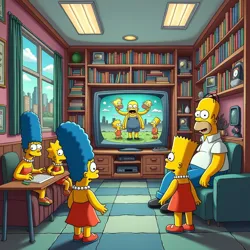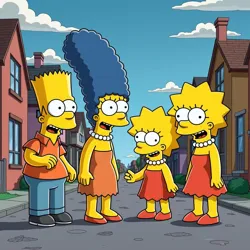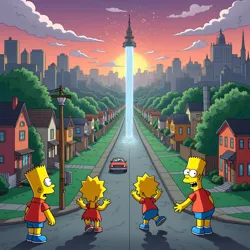Springfieldian Audiovisual Narratives

Springfield's diverse media productions across television film and digital platforms reflecting cultural evolution.
fictional locale of Springfield
1989
television
2007
Golden Donut Awards
Springfieldian Audiovisual Narratives encompass a diverse and evolving collection of media productions originating from or concerning the fictional locale of Springfield. This body of work, primarily spanning television, film, and digital platforms, has become a significant cultural phenomenon, reflecting and often satirizing societal trends, generational shifts, and the ever-changing media landscape itself. From its groundbreaking beginnings in animated sitcoms to its contemporary forays into online content, Springfieldian media continues to engage audiences with its unique blend of humor, social commentary, and relatable characters.
Early Era Television (1989-2007): The Foundational "Simpsons"
The cornerstone of Springfieldian audiovisual narratives is undoubtedly the eponymous television program, The Simpsons. Launching its initial run in 1989, this animated sitcom rapidly ascended to become a global cultural touchstone. Its innovative approach to animation, combined with its sharp wit and incisive satire of suburban life, resonated deeply with audiences across demographics and geographical boundaries. The series distinguished itself through its complex character development, its layered humor that appealed to both children and adults, and its willingness to tackle contemporary social and political issues with a comedic lens.
 The Simpsons animated sitcom a global cultural phenomenon known for satire and character development.
The Simpsons animated sitcom a global cultural phenomenon known for satire and character development.The Simpsons achieved remarkable longevity during this initial phase, broadcasting continuously for nearly two decades. This sustained run allowed for an unprecedented level of character evolution and narrative depth within the sitcom format. The inhabitants of Springfield, including the central family unit of Homer, Marge, Bart, Lisa, and Maggie Simpson, became deeply ingrained in the public consciousness. Their individual quirks, interpersonal dynamics, and recurring situations provided a rich tapestry for exploring universal themes of family, community, work, and societal expectations. The show's writers and animators consistently pushed creative boundaries, experimenting with surreal humor, self-referential jokes, and parodies of popular culture, contributing to its enduring appeal and critical acclaim. This period established The Simpsons not merely as a television program, but as a cultural institution that shaped the landscape of animated comedy and influenced subsequent generations of comedic storytellers.
Cultural Impact and Critical Reception
The impact of The Simpsons on global culture is undeniable. It is credited with revitalizing the animated sitcom format for adult audiences, paving the way for numerous subsequent animated series that adopted its satirical and character-driven approach. Its influence extends beyond television, permeating popular language, fashion, and artistic expression. Catchphrases and characters from the show have become instantly recognizable worldwide, and its visual style has been widely imitated and referenced in other media.
Critically, The Simpsons during this era garnered widespread praise and numerous accolades. It received consistent recognition for its writing, animation, voice acting, and overall comedic innovation. Awards and nominations from prestigious organizations underscored its artistic merit and cultural significance. Beyond formal recognition, the series fostered a dedicated and engaged fanbase, contributing to its enduring popularity and solidifying its position as a landmark achievement in television history. Its satirical edge and willingness to challenge societal norms, while maintaining a core of familial warmth and humor, resonated with viewers and critics alike, establishing a high standard for animated comedy that continues to be referenced and admired.
Feature Film Expansion (2007-2017): Venturing onto the Big Screen
In 2007, the Springfieldian narrative universe expanded into feature film with the release of The Simpsons Movie. This marked a significant transition for the franchise, bringing the beloved animated family to a larger cinematic canvas. The film was met with considerable anticipation from long-time fans and general audiences alike, eager to see how the characters and humor of the television series would translate to a feature-length format.
 The Simpsons Movie's successful transition to cinema expanding the narrative and visual scope.
The Simpsons Movie's successful transition to cinema expanding the narrative and visual scope.The Simpsons Movie proved to be a critical and commercial success, demonstrating the enduring appeal of the franchise and its capacity to resonate with audiences beyond the television screen. The film retained the signature humor and satirical edge of the series while also leveraging the expanded runtime and visual possibilities of cinema to tell a more complex and visually dynamic story. The narrative centered on an Environmental crisis in Springfield, allowing for broader social commentary and large-scale comedic set pieces that would have been challenging to execute within the constraints of a television episode. The film's success solidified The Simpsons as a multimedia franchise with the capacity to thrive across different platforms.
Return to Cinema and Shifting Tones
A decade later, in 2017, the Springfieldian cinematic universe expanded further with The Simpsons Movie 2: We're Back...D'Oh!. This sequel aimed to capitalize on the established popularity of the first film while exploring new narrative territory and thematic concerns. While details regarding the specific plot and reception of this second film are less widely circulated, its existence indicates a continued interest in extending the Springfieldian narrative universe through feature-length productions.
The ten-year gap between the two films suggests a deliberate approach to cinematic releases, possibly prioritizing quality and narrative innovation over rapid sequels. The title, We're Back...D'Oh!, hints at a self-aware and potentially meta-comedic approach, acknowledging the passage of time and the inherent challenges of revisiting established characters and storylines in a sequel format. This second cinematic venture further cemented the franchise's adaptability and its willingness to experiment with different storytelling approaches and formats to maintain audience engagement.
Spin-offs and Short-Form Content (2009-2016): Branching Narratives
The period between 2009 and 2016 witnessed an exploration of spin-off productions and short-form content within the Springfieldian audiovisual narrative sphere. These ventures aimed to diversify the franchise's offerings, potentially catering to niche audiences or experimenting with different comedic styles and formats. While some of these endeavors proved short-lived, they represent an attempt to expand the Springfieldian universe beyond the core Simpsons television series and films.
The Krusty The Clown Hour, launched in 2009, sought to capitalize on the popularity of the character Krusty the Clown, a long-standing and beloved figure within the Simpsons universe. Krusty, the jaded and often cynical children's entertainer, had become a fan favorite for his comedic antics and his satirical portrayal of show business and celebrity culture. However, The Krusty The Clown Hour experienced a brief broadcast run, suggesting that while the character held individual appeal, a standalone series centered solely on him may not have captured the broader audience interest necessary for sustained success. The reasons for its short run could be varied, potentially ranging from format limitations to narrative challenges in sustaining a full series centered on a character initially conceived as a supporting player.
Meta-Narratives and Concise Storytelling
The Itchy and Scratchy Show, also debuting in 2011, took a different approach to spin-off content. Rather than focusing on a specific character, it centered on the "show-within-a-show" concept of The Itchy and Scratchy Show, a violent and cartoonish program frequently featured within The Simpsons. This spin-off represented a meta-narrative experiment, delving into the exaggerated and often disturbing world of Itchy and Scratchy, the perpetually warring cat and mouse duo. Its brief run in 2011 might indicate a more niche appeal, perhaps targeting viewers specifically interested in the darkly comedic and hyper-violent aspects of The Itchy and Scratchy Show as presented within the broader Simpsons context.
What's Been Happening In Springfield, a collection of four short-form productions released between 2015 and 2016, signaled a further diversification of Springfieldian media formats. This collection of shorts suggests an exploration of concise storytelling and potentially online distribution methods, reflecting the evolving media consumption habits of audiences in the mid-2010s. Short-form content was gaining traction online, and What's Been Happening In Springfield may have been an attempt to adapt to this trend, offering smaller, more digestible narratives that could be easily shared and consumed on digital platforms. This venture highlights the franchise's awareness of shifting media landscapes and its willingness to experiment with new formats to maintain relevance and engagement.
Generational Evolution (2018-2025): Shifting Perspectives
The period from 2018 to 2025 marks a phase of generational evolution within Springfieldian audiovisual narratives, characterized by productions that focus on the descendants of established characters and explore themes relevant to new generations. These projects suggest a conscious effort to adapt the franchise to changing demographics and societal concerns, while still retaining the core comedic and satirical elements that define Springfieldian media.
Springfield: The Next Generation, launched in 2018 and projected to run until 2025, represents a significant shift in narrative focus. This series centers on the children of the original Simpsons characters as they navigate adulthood and the complexities of contemporary life. By shifting the spotlight to a younger generation, Springfield: The Next Generation opens up new avenues for exploring themes of identity, generational differences, and the challenges faced by young people in the modern world. It allows for the introduction of new characters and perspectives while still maintaining a connection to the established Springfieldian universe through the presence of familiar family lineages. This series indicates a strategic approach to franchise longevity, ensuring its continued relevance by evolving alongside its audience and addressing contemporary concerns through the lens of a new generation.
Topical Focus and Digital Platforms
Todd's Test of Faith, which aired from 2020 to 2024, takes a more focused and topical approach, centering on the character of Todd Flanders, the son of Ned Flanders, a devoutly religious neighbor of the Simpsons. This series delves into themes of faith, doubt, and the questioning of religious dogma in the modern age. The tagline, "Questioning the big guy upstairs... and downstairs," immediately establishes the series' central conflict and its willingness to engage with potentially sensitive and controversial topics.
The description of Todd's Test of Faith as a YouTube atheist channel further underscores its contemporary relevance. The series portrays Todd Flanders as an ex-fundamentalist who now critiques religion, debates philosophy, and shares his existential reflections through online video content. This format directly engages with the digital media landscape and the prevalence of online discourse surrounding religion, atheism, and philosophical inquiry. The description highlights the series' blend of "deep theological discussions" with "reaction videos" and "rage-fuelled rants," suggesting a multifaceted approach to exploring Todd's journey and the broader themes of faith and skepticism. The mention of Apu Nahasapeemapetilon, another long-standing Springfieldian character, guest-starring to provide "new angles to think about" further connects the series to the established universe while also introducing diverse perspectives on the central themes. The unexpected online following, encompassing both devout Christians and militant atheists, reflects the often-polarized nature of online discussions surrounding religion and belief, adding another layer of contemporary social commentary to the series.
Whilst Rodd, his wife and four children have joined a Megachurch and become extremely devout, Todd is atheist and raises his family to not believe in anything.
This quote from the provided description encapsulates the core premise of Todd's Test of Faith, highlighting the generational and ideological divide within the Flanders family and the series' exploration of contrasting belief systems in a contemporary context.
Digital Media Integration (2022-2025): Navigating the Online Sphere
The most recent phase in Springfieldian audiovisual narratives, spanning 2022 to 2025, is characterized by a direct engagement with digital media platforms and the impact of online culture on entertainment and celebrity. KrustTok exemplifies this trend, focusing on the character of Krusty the Clown's desperate and often misguided attempts to maintain relevance in the age of social media.
 Krusty the Clown struggling with social media in KrustTok satirizing online fame and cringe culture.
Krusty the Clown struggling with social media in KrustTok satirizing online fame and cringe culture.KrustTok directly confronts the challenges faced by established media figures in the rapidly evolving digital landscape. The tagline, "Like & subscribe or I’m finished, folks!", immediately captures the sense of desperation and the performative nature of online content creation. The series portrays Krusty as struggling to understand and adapt to social media trends, mispronouncing slang, and inadvertently going viral for all the wrong reasons. His attempts at "deep, emotional" apology videos, invariably followed by merchandise drops, satirize the often-insincere and commercially driven nature of online apologies and influencer culture. His "terrible reaction videos" and "unhinged live streams at 3 AM" further highlight his disconnect from contemporary online trends and his increasingly chaotic attempts to stay relevant.
"HIT THAT FOLLOW BUTTON, OR I’M GOING BACK TO RADIO!"
This quote, presumably a catchphrase or tagline associated with KrustTok, encapsulates Krusty's frantic attempts to gain online followers and his fear of losing relevance in the digital age. It underscores the series' satirical commentary on the pressures of online fame and the often-absurd lengths to which individuals will go to maintain it.
Generational Divide and Cringe Culture
The description of Krusty's biggest demographic being "45-year-old boomers and irony-poisoned teens" further emphasizes the generational divide and the often-unintentional humor that arises from misinterpretations of online culture. The "boomers" may be drawn to Krusty out of nostalgia or a genuine but perhaps outdated appreciation for his comedic style, while the "irony-poisoned teens" likely find humor in his cringe-worthy attempts to be "hip" and relevant. His constant pivots, from motivational speaker to "Krusty the Crypto Clown," satirize the rapid and often superficial shifts in online trends and the pressure to constantly reinvent oneself to maintain online attention. KrustTok serves as a sharp and humorous commentary on the anxieties and absurdities of navigating fame and relevance in the age of social media, utilizing the established character of Krusty the Clown to explore these contemporary themes.
Springfieldian Media Awards: The Golden Donut Recognition
To formally acknowledge and celebrate excellence within the Springfieldian audiovisual narrative sphere, the Golden Donut Awards were established. These awards, named in playful homage to a beloved Springfieldian culinary staple, recognize outstanding achievements across various categories of media production originating from or concerning Springfield. The Golden Donut Awards serve as a prestigious accolade within the Springfieldian entertainment industry, honoring creativity, innovation, and cultural impact.
The awards ceremony, held annually in Springfield, brings together creators, performers, and industry professionals from across the spectrum of Springfieldian media. Nominees and winners are selected by a panel of esteemed judges representing diverse fields of expertise, ensuring a comprehensive and impartial evaluation process. The Golden Donut Awards not only recognize individual achievements but also contribute to fostering a sense of community and shared purpose within the Springfieldian media landscape, encouraging continued innovation and artistic excellence.
Award Categories and Significance
The Golden Donut Awards encompass a wide range of categories, reflecting the diverse forms and genres within Springfieldian audiovisual narratives. These categories are regularly reviewed and updated to ensure they remain relevant to the evolving media landscape and to acknowledge emerging trends and platforms. Examples of established categories include:
The Golden Donut Awards play a vital role in shaping the Springfieldian media industry by highlighting exemplary work, encouraging creative competition, and providing a platform for recognition and celebration. The awards ceremony itself has become a highly anticipated event, drawing media attention and further promoting the visibility and cultural significance of Springfieldian audiovisual narratives. Winning a Golden Donut Award is considered a high honor, signifying peer recognition and contributing to the career advancement of recipients.
Conclusion: An Evolving Narrative Landscape
Springfieldian audiovisual narratives represent a dynamic and continuously evolving body of work. From its groundbreaking origins in The Simpsons television series to its contemporary explorations of digital platforms and generational shifts, Springfieldian media has demonstrated a remarkable capacity for adaptation and reinvention. It has consistently engaged audiences with its unique blend of humor, satire, and relatable characters, while also reflecting and commenting upon the ever-changing social, cultural, and media landscapes. The franchise's expansion into feature films, spin-offs, short-form content, and digital series underscores its commitment to innovation and its enduring appeal across diverse formats and platforms. As Springfieldian media continues to evolve, it promises to remain a significant and influential force in the world of audiovisual storytelling, reflecting and shaping the narratives that resonate with audiences for generations to come.